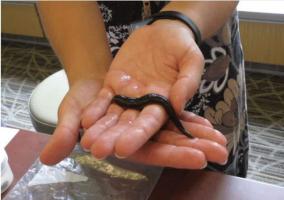RevealA newly discovered bloodsucking, olive-green leech with three jaws and as many as 59 teeth has been found about 40 miles outside of downtown Washington.
A team led by a researcher at the Smithsonian’s National Museum of Natural History discovered the new species, Macrobdella mimicus, in the swamps of southern Maryland’s Charles County. It’s the first time since 1975 a new medicinal leech species has been found in North America.
Anna Phillips, the museum’s curator of parasitic worms, led the team that made the discovery. She waded in murky waters for days wearing shorts — with bare legs and sandals — looking for leeches under wood, grass and trash in swampy, algae-covered ponds near Nanjemoy, a small community southwest of Waldorf.
The researchers’ findings of the new species, which is about the size of a cigarette, were published this month in the Journal of Parasitology.
Leeches are parasitic worms, and some feed on the blood of their hosts. In the 1700s and 1800s, doctors sometimes used them to treat fevers and headaches by “ridding a patient’s body of ‘bad blood,’ ” according to Smithsonian experts. There are more than 700 species of leeches in the world.
About four years ago, Phillips and her team started to dig into a well-known leech species known to live from the East Coast to the Rocky Mountains, including Canada and the southern United States. The researchers, from universities across North America, wanted to determine whether the same species lived in such a large geographical area. “You see a broad distribution with a different geography, and we were suspicious,” Phillips said. “Leeches don’t crawl across dry land, so we wanted to see if there was more going on.”
They collected hundreds of samples of leeches, including six found in swampy ponds in southern Maryland. Using DNA sequencing and comparisons to more than 100 leech specimens, they discovered the new species. The leech looked like the well-known M. decora species, but something was different.
To distinguish among species, parasitologists usually look at the way pores are arranged on the bottom of a leech. Leeches are hermaphrodites and have what’s known as accessory pores that secrete mucus, which helps them stick together while mating.
Scientists noticed these leeches had four accessory pores grouped in two rows, like other leeches, but these sets of pores were farther back on their bodies. They named the new species Macrobdella mimicus after the Greek word for “imitator” or “actor.”
“They were overlooked,” Phillips said. “It was unrecognized that these were different.”
The species lives primarily in the Piedmont region of the United States between the Appalachian Mountains and the Atlantic coast.
Phillips said she spent hours with ticks, flies, mosquitoes and chiggers around her, walking in squishy, mucky water while trying to find leeches in ponds. She was unfazed when a leech would grab on to her leg. Leeches bite only when they’re hungry, she said.
Indeed, when a leech attaches itself to her, Phillips “gets pretty excited,” she said.
“They come in very stealthy,” she said. “They use their tail sucker, which is a muscle, to attach and then spread their mouth out and bite.”
The encounter doesn’t hurt — “nothing like a bee sting,” she said — and she uses a fingernail to lift them off. After a leech finishes, “it will just itch a little.”
“Ticks and mosquitoes are way more scary than leeches,” she said, adding that in her 15 years of studying leeches, she has been bitten many times.
The leech uses its teeth to bite and siphon blood from its prey — usually frogs, fish and tadpoles, along with the occasional human, Phillips said. It can suck two to five times its body weight in blood because of pockets that expand in its digestive system. Leeches can go up to a year without eating, and blood meals can take months to digest.
To declare a new species, the team followed standards set by the International Commission on Zoological Nomenclature, which keeps rules and makes recommendations for the scientific naming of animals. Phillips said she and her team are presenting their findings at conferences and spreading the word on social media.
Michael Tessler, a postdoctoral fellow at the American Museum of Natural History in New York, said the new species is unique. He compared it to the feeling of having an “amazing find of anything new in your backyard.”
“This is really quite close to major metropolitan areas where people have professionally studied leeches,” Tessler said. “People have had this under their noses for so long and not known it."

